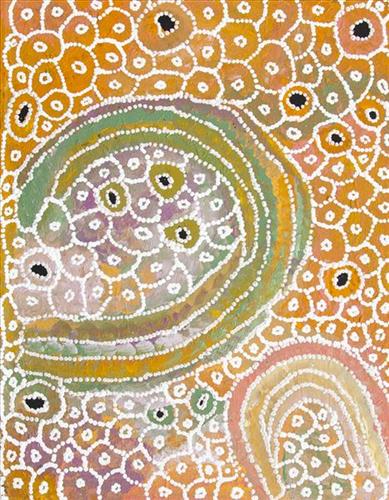111582084024
Yirriya
“I paint my dad’s country Yirriya. It’s got running water coming out of the ground into a big dam, surrounded by lots of trees. It’s really green. It’s on Rawlinson Ranges 50-60km from Warakurna. Nearby is Circus Waters where my dad was born we’d go swimming there, Lake Christopher is nearby too. All part of his country. We would go hunting, turkey, emu, kangaroo, look for bardi/lungi (witchetty grub), honey ants, yellow berries. It’s an outstation we call it home. We grew up in that place. Family from Warakurna, Docker River, Wingelina, Warnan would come and stay. Good memories of that place.”
– Roxanne Newberry
Warakurna is a large Aboriginal community, located in the Goldfields-Esperance region of Western Australia, within the Shire of Ngaanyatjarraku it lies near the foot of the spectacular Rawlinson Range, 300 kilometres west of Uluru (Ayers Rock) near the meeting of the borders of Western Australia, South Australia and the Northern Territory. Ngaanyatjarra people have strong ties with neighbouring Western Desert groups, including Martu.
This work portrays an area of Country that can be interpreted in multiple ways. Firstly, the image may be read as an aerial representation of a particular location known to the artist- either land that they or their family travelled, from the pujiman (traditional, desert dwelling) era to now. During the pujiman period, Martu would traverse very large distances annually in small family groups, moving seasonally from water source to water source, and hunting and gathering bush tucker as they went. At this time, one’s survival depended on their intimate knowledge of the location of resources; thus physical elements of Country, such as sources of kapi (water), tali (sandhills), different varieties of warta (trees, vegetation), ngarrini (camps), and jina (tracks) are typically recorded with the use of a system of iconographic forms universally shared across the desert.
An additional layer of meaning in the work relates to more intangible concepts; life cycles based around kalyu (rain, water) and waru (fire) are also often evident. A thousands of year old practice, fire burning continues to be carried out as both an aid for hunting and a means of land management today. As the Martu travelled and hunted they would burn tracts of land, ensuring plant and animal biodiversity and reducing the risk of unmanageable, spontaneous bush fires. The patchwork nature of regrowth is evident in many landscape works, with each of the five distinctive phases of fire burning visually described with respect to the cycle of burning and regrowth.
Finally, metaphysical information relating to a location may also be recorded; Jukurrpa (Dreaming) narratives chronicle the creation of physical landmarks, and can be referenced through depictions of ceremonial sites, songlines, and markers left in the land. Very often, however, information relating to Jukurrpa is censored by omission, or alternatively painted over with dotted patterns.




